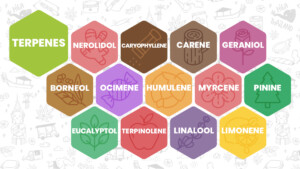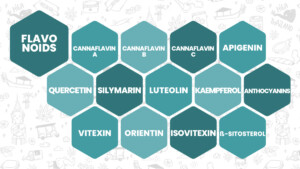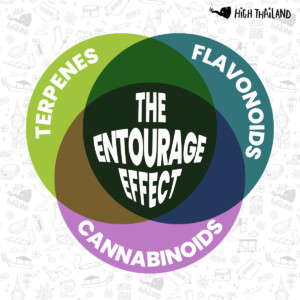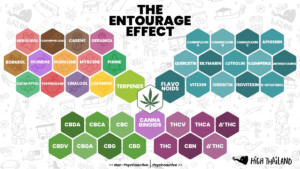|
Getting your Trinity Audio player ready...
|
Introduction to Cannabis and the Entourage Effect
Cannabis, a plant known for its wide range of applications and effects, has been the subject of extensive research and heated debate for decades. One of the key factors that contribute to the complex and diverse effects of cannabis is the entourage effect. To better understand this phenomenon, let’s delve into the basic chemical components of cannabis, including cannabinoids, terpenes, and flavonoids.
Cannabinoids
Cannabinoids are the primary chemical compounds found in cannabis plants, with over 100 different types identified so far. They interact with the body’s endocannabinoid system (ECS) to produce various effects, both therapeutic and recreational. The two most well-known cannabinoids are delta-9-tetrahydrocannabinol (THC) and cannabidiol (CBD). THC is responsible for the psychoactive effects, or the “high,” while CBD has gained popularity for its potential health benefits without the psychoactive effects.
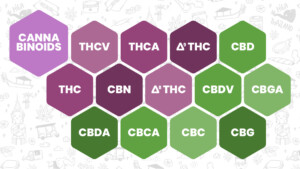
Infographic: Psychoactive cannabinoids like THC on the upper left and CBD and the non-psychoactive cannabinoids on the bottom right
Terpenes
Terpenes are aromatic compounds found in various plants, including cannabis. They are responsible for the distinctive scents and flavors associated with different strains of cannabis. More than 200 different terpenes have been identified in the plant, with some playing a significant role in the overall effects of cannabis. For example, myrcene, the most common terpene in cannabis, is known for its sedative and anti-inflammatory properties. Limonene, another prevalent terpene, offers a citrus scent and has been associated with mood-enhancing and stress-relieving effects.
Flavonoids
Flavonoids are a class of plant compounds responsible for the vibrant colors of fruits, flowers, and leaves. In cannabis, flavonoids contribute to the plant’s color, taste, and aroma. Over 20 different flavonoids have been identified in cannabis, with some boasting potential health benefits. For instance, cannflavins A and B, unique to cannabis, have demonstrated anti-inflammatory properties.
The Entourage Effect in Cannabis: Synergy of Compounds and Its Impact on Experience
As we continue our journey into the world of cannabis and the entourage effect, it is essential to understand what the entourage effect is and how it relates to the overall effects of cannabis. This phenomenon suggests that the various compounds found within the cannabis plant, including cannabinoids, terpenes, and flavonoids, interact synergistically to enhance their individual effects, leading to a more comprehensive experience for the user.
What is the Entourage Effect?
The entourage effect is a theory that proposes the compounds within cannabis do not work in isolation but rather in a coordinated manner. This means that the effects of cannabis are not solely determined by the presence of individual cannabinoids like THC or CBD. Instead, the full spectrum of compounds, including terpenes and flavonoids, work together to create unique and diverse effects that differ from those produced by isolated compounds.
The concept of the entourage effect was first introduced in 1998 by Israeli researchers Raphael Mechoulam and Shimon Ben-Shabat. They discovered that the endocannabinoid system’s (ECS) receptors were more effectively activated when the entire cannabis compound spectrum was present, compared to individual cannabinoids alone.
How the Entourage Effect Relates to the Overall Effects of Cannabis
The entourage effect plays a significant role in the overall effects of cannabis, as the combined action of various compounds results in a wide array of experiences for users. The synergistic interaction between these compounds contributes to the nuanced effects that cannabis users report. Here are a few ways the entourage effect impacts the overall effects of cannabis:
- Modulation of THC effects: The presence of CBD can modulate the psychoactive effects of THC, reducing feelings of anxiety or paranoia that some users experience. This interaction can help users enjoy the benefits of both compounds without feeling overwhelmed by THC’s psychoactive properties.
- Enhanced therapeutic potential: Terpenes, which boast their own therapeutic properties, may enhance the medicinal benefits of cannabinoids. For instance, the terpene myrcene has sedative effects and may boost the pain-relieving properties of cannabinoids like THC and CBD.
- Strain-specific experiences: The unique combination of cannabinoids, terpenes, and flavonoids in different cannabis strains can lead to specific effects, such as relaxation, euphoria, or creativity. The entourage effect is responsible for the distinctive experiences associated with each strain, as the compounds work together to create a unique profile.
Understanding the entourage effect is crucial for both recreational and medical users, as it highlights the importance of considering the full spectrum of cannabis compounds rather than focusing solely on cannabinoids like THC or CBD. By recognizing the synergistic nature of these compounds, we can harness the full potential of cannabis and develop tailored products to meet the diverse needs and preferences of users.
The timeline of the scientific progress in unravelling the Entourage Effect

CBD is first isolated by Roger Adams, an American chemist, although its structure is not fully elucidated at this time.
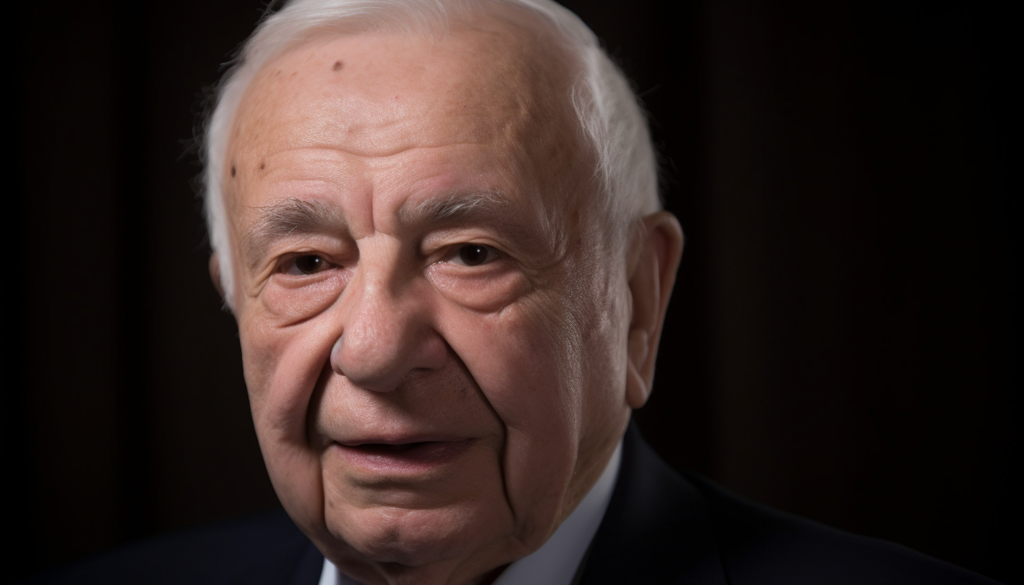
Dr. Raphael Mechoulam, an Israeli scientist, isolates and identifies the primary psychoactive compound in cannabis, delta-9-tetrahydrocannabinol (THC).
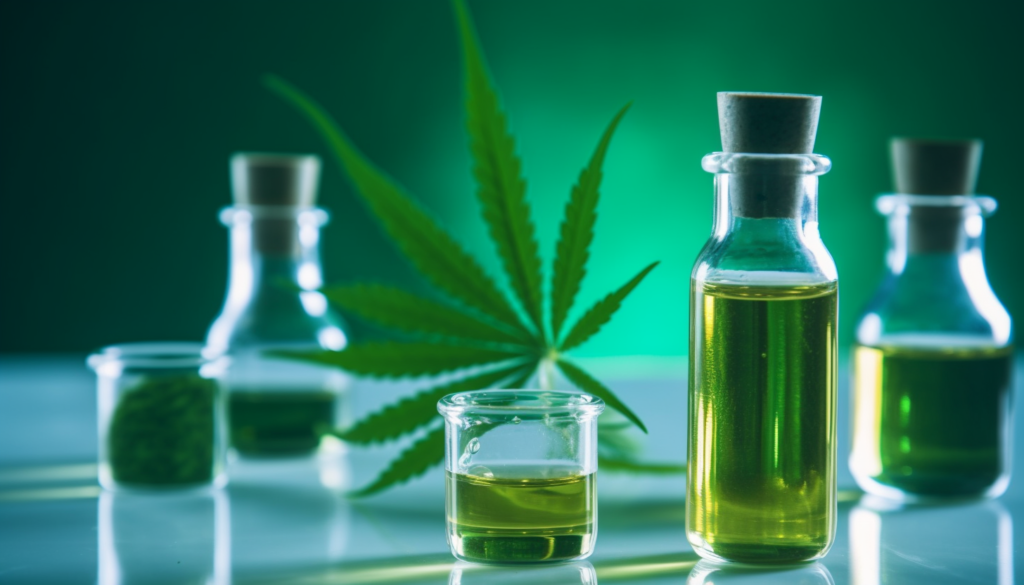
Researchers begin studying the effects of individual cannabinoids, primarily focusing on THC and CBD.

William (Bill) Devane, who was part of Dr. Mechoulam's research team, discover anandamide, the first endocannabinoid, which plays a crucial role in the human endocannabinoid system.
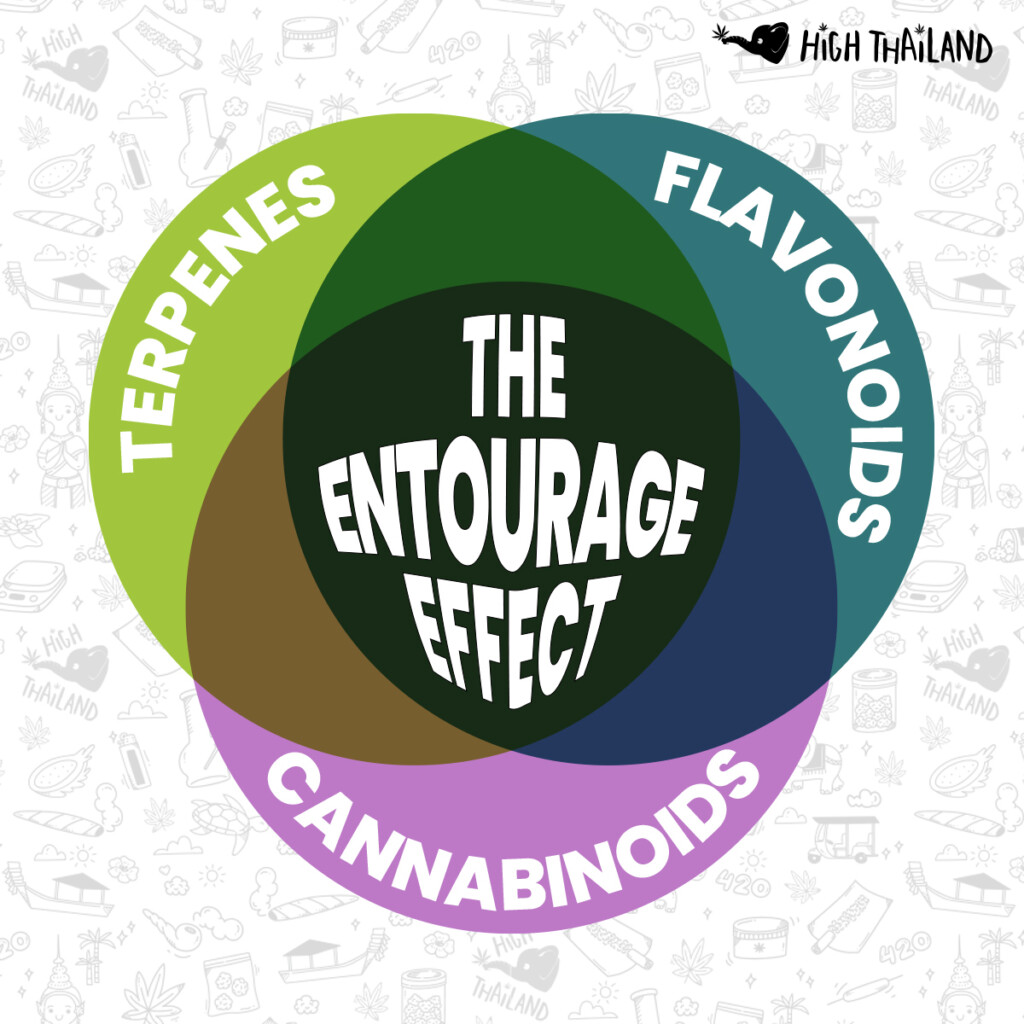
Dr. Mechoulam and fellow researchers propose the "entourage effect" hypothesis, suggesting that cannabis compounds may work together to create a synergistic effect

Dr. Ethan Russo, a neurologist and cannabis researcher, publishes a seminal paper, "The Case for the Entourage Effect and Conventional Breeding of Clinical Cannabis," providing evidence for the entourage effect and discussing its implications for cannabis breeding and medicine.
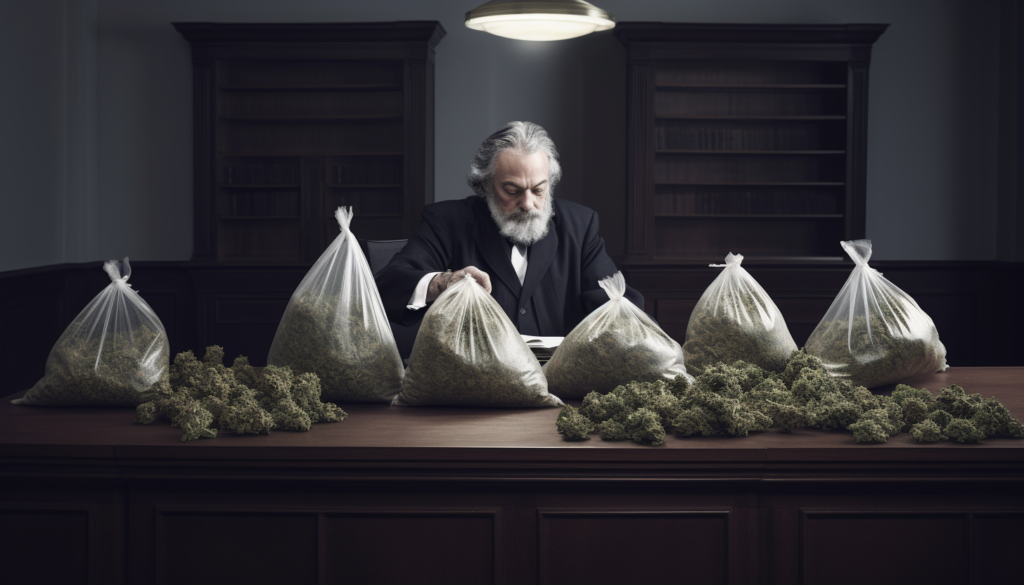
The legal landscape surrounding cannabis begins to shift, allowing for more extensive research into the plant and its components. Studies during this time increasingly focus on the interactions between cannabinoids, terpenes, and flavonoids, providing further evidence for the entourage effect.

A study by Dr. Russo, "Taming THC: potential cannabis synergy and phytocannabinoid-terpenoid entourage effects," highlights the role of terpenes in modulating the effects of THC and other cannabinoids, strengthening the evidence for the entourage effect.
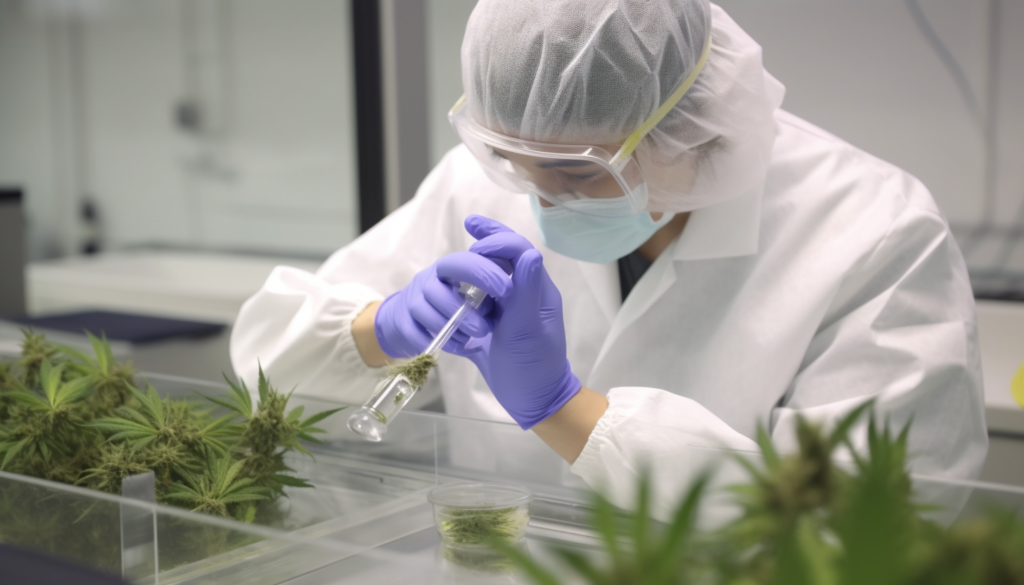
Research into the entourage effect expands, with studies exploring the potential therapeutic applications of specific cannabinoid and terpene combinations, as well as investigating the role of lesser-known cannabinoids in the entourage effect.
Since 2020 the entourage effect gains increasing recognition and acceptance in the scientific community, shaping the future of cannabis research, breeding, and medical applications.
Uncovering the Hidden Depths of the Entourage Effect: Lesser-Known Aspects and Personal Experiences
In our exploration of the entourage effect in cannabis, we have discussed the synergistic interaction between cannabinoids, terpenes, and flavonoids, contributing to the plant’s overall effects. However, there are some lesser-known aspects of the entourage effect that deserve attention. By diving into these less commonly discussed factors and sharing unique examples or personal experiences, we can gain a more in-depth understanding of this fascinating phenomenon.
Lesser-Known Aspects of the Entourage Effect
- Terpene interplay with cannabinoids: Although the focus is often on the interactions between THC and CBD, terpenes can also influence the effects of cannabinoids. For example, the terpene beta-caryophyllene has a unique ability to bind directly to the CB2 receptors in the endocannabinoid system (ECS), just like cannabinoids do. This interaction has the potential to enhance the anti-inflammatory and analgesic effects of other cannabinoids.
- Impact of flavonoids: Flavonoids, though not as widely studied as cannabinoids and terpenes, can also contribute to the entourage effect. The unique flavonoids found in cannabis, such as cannflavin A and cannflavin B, have demonstrated anti-inflammatory properties that could potentially work synergistically with cannabinoids to enhance their therapeutic potential.
- Individual differences: Each person’s endocannabinoid system and genetic makeup can influence how they experience the entourage effect. Factors like individual metabolism, tolerance, and the density of cannabinoid receptors can impact the way a person experiences the effects of cannabis.
Unique Examples and Personal Experiences
- Outdoor vs. indoor grown cannabis: Some users have reported feeling a more potent high from outdoor-grown cannabis compared to indoor-grown plants, despite the latter often having higher trichome coverage. This anecdotal evidence suggests that the entourage effect may vary based on cultivation methods, with outdoor-grown plants potentially offering a different combination of cannabinoids, terpenes, and flavonoids that lead to a more intense experience.
- Different effects from similar strains: Cannabis users often report varying experiences when using different strains that are supposedly similar in their cannabinoid and terpene profiles. This variation could be due to the entourage effect, with subtle differences in the composition of compounds leading to unique experiences for each user.
- Microdosing: Some cannabis users have found success in microdosing, which involves consuming small amounts of cannabis to achieve subtle therapeutic effects without the typical psychoactive high. This method highlights the importance of understanding the entourage effect, as it allows users to find the right balance of compounds to achieve their desired outcome.

Microdose Cookies baked by Baked
By exploring these lesser-known aspects of the entourage effect and considering personal experiences, we can gain a more comprehensive understanding of the complex world of cannabis. This knowledge can help users make more informed choices about the products they use, while also paving the way for future research and product development that harnesses the full potential of the entourage effect.
Harnessing the Entourage Effect: Medical Benefits and Applications in Modern Medicine
The entourage effect in cannabis—the synergy between cannabinoids, terpenes, and flavonoids—has piqued the interest of researchers and medical professionals alike. With the potential to enhance the therapeutic effects of cannabis, the entourage effect offers a wealth of opportunities for medical applications. This article will discuss the possible medical benefits and applications of the entourage effect in the field of medicine.
Potential Medical Benefits of the Entourage Effect
- Improved efficacy: The entourage effect can lead to increased efficacy in treating various medical conditions, as the combined action of multiple compounds may produce more potent therapeutic effects compared to isolated cannabinoids.
- Reduced side effects: By leveraging the entourage effect, researchers can develop cannabis-based medications that provide therapeutic benefits with fewer side effects. For example, the presence of CBD can help counteract the psychoactive effects of THC, reducing anxiety and paranoia in some users.
- Personalized medicine: The entourage effect can potentially pave the way for personalized cannabis-based medicine, where patients can receive tailored formulations to target specific medical conditions or symptoms, taking into account individual variations in endocannabinoid systems and genetics.
Applications of the Entourage Effect in Medicine
- Pain management: The entourage effect has shown promise in the area of pain management, with the combined action of cannabinoids, terpenes, and flavonoids potentially providing more effective relief than isolated compounds. For example, the terpene myrcene, known for its sedative and analgesic properties, may work synergistically with THC and CBD to enhance their pain-relieving effects.
- Mental health: The entourage effect can also play a role in treating mental health conditions such as anxiety, depression, and post-traumatic stress disorder (PTSD). The synergistic interactions between cannabinoids and terpenes can modulate the effects of THC, promoting relaxation and stress relief without causing severe psychoactive effects.
- Neurodegenerative disorders: The entourage effect has the potential to contribute to the treatment of neurodegenerative disorders, such as Alzheimer’s, Parkinson’s, and multiple sclerosis. The combined action of various compounds in cannabis can offer anti-inflammatory, antioxidant, and neuroprotective effects that may slow the progression of these diseases.
- Cancer: Research has shown that the entourage effect can potentially play a role in cancer treatment, with various cannabinoids and terpenes exhibiting anti-tumor and anti-cancer properties. The synergy between these compounds could enhance the therapeutic effects of cannabis, providing relief from symptoms such as pain, nausea, and loss of appetite while possibly slowing tumor growth.
The entourage effect offers numerous potential benefits and applications in the field of medicine, with the combined action of cannabinoids, terpenes, and flavonoids potentially providing more effective and targeted treatments for various conditions. As research continues, we can expect to see further advancements in the understanding of the entourage effect and the development of innovative therapies that harness its potential.
Debunking Myths: Common Misconceptions and Criticisms of the Entourage Effect
As the entourage effect gains traction in both scientific and public discourse, it’s important to address the common misconceptions and criticisms surrounding this fascinating phenomenon. By clarifying misunderstandings and presenting a balanced view, we can foster a more accurate understanding of the entourage effect in cannabis and its potential implications.

Meme Break: Posted on blueprintcannabis.co
Misconception 1: The entourage effect is just a marketing gimmick
Critics argue that the entourage effect is nothing more than a marketing ploy used by the cannabis industry to promote whole-plant or full-spectrum products. While it’s true that the concept has been adopted by marketers, the entourage effect is backed by scientific research. Multiple studies have demonstrated the synergistic effects of cannabinoids, terpenes, and flavonoids, supporting the idea that these compounds work together to produce enhanced outcomes compared to isolated compounds.
Misconception 2: All cannabis compounds contribute equally to the entourage effect
Another common misconception is that all cannabis compounds contribute equally to the entourage effect. In reality, the contribution of each compound may vary depending on factors such as concentration, individual biological makeup, and the specific combination of compounds present. While some compounds like THC and CBD have significant effects, others may have more subtle roles or require specific conditions to exhibit synergy.
Misconception 3: The entourage effect is always beneficial
It’s essential to recognize that the entourage effect may not always result in positive outcomes. While the synergistic action of cannabis compounds can enhance therapeutic effects, it’s possible that the combination of certain compounds may also exacerbate side effects or negatively impact specific individuals. This highlights the need for continued research and a personalized approach to cannabis-based medicine.
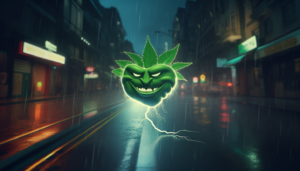
AI Stockfoto: Midjourney prompt “evil smiling cannabis leaf mascott on the streets of bangkok, 3d, rendered, dramatic lightning”
Criticism 1: Lack of conclusive evidence
One of the main criticisms of the entourage effect is the lack of conclusive scientific evidence to support its existence. While there are numerous studies indicating the potential for synergy between cannabis compounds, critics argue that more rigorous, controlled research is necessary to establish a definitive link between the entourage effect and the overall effects of cannabis.
Criticism 2: Difficulty in isolating specific compound interactions
Another criticism of the entourage effect is the challenge of isolating specific compound interactions to determine their individual contributions to the overall effects of cannabis. Due to the complex nature of the plant and the vast array of compounds present, researchers have faced difficulty in pinpointing the precise mechanisms behind the entourage effect.
Addressing Criticisms and Moving Forward
As we strive to better understand the entourage effect, it’s essential to acknowledge the criticisms and challenges while also recognizing the potential benefits that this phenomenon may offer. Continued research and investment in controlled, well-designed studies can help shed light on the intricacies of the entourage effect and its potential applications in medicine and beyond.
Shaping the Entourage Effect: The Influence of Cannabis Growers and Cultivators
The entourage effect, or the synergistic interplay between cannabinoids, terpenes, and flavonoids, plays a crucial role in determining the overall effects of cannabis. Growers and cultivators have a significant influence on this phenomenon, with their breeding and growing techniques directly impacting the composition of compounds present in the final product. This article will explore the role of cannabis growers in shaping the entourage effect and delve into the techniques they employ to harness its potential.
Breeding Techniques and Strain Selection
Cannabis breeders play an essential role in developing strains with specific combinations of cannabinoids, terpenes, and flavonoids, thus influencing the entourage effect. By crossbreeding different strains, they can create new hybrids that offer unique effects and experiences for users. Some key aspects of strain development include:
- Cannabinoid profile: Breeders can selectively cross strains to develop cannabis plants with specific cannabinoid ratios, such as high THC, high CBD, or balanced THC:CBD profiles. These variations can impact the entourage effect by modulating the psychoactive and therapeutic properties of the final product.
- Terpene content: By selecting strains with distinct terpene profiles, breeders can influence the aroma, flavor, and potential therapeutic benefits of the cannabis plant. Terpenes not only contribute to the sensory experience but also interact with cannabinoids to enhance or modulate their effects.
Growing Techniques and Environmental Factors
Cultivators also have a significant impact on the entourage effect through their choice of growing techniques and environmental conditions. Factors such as lighting, temperature, humidity, and nutrients can affect the production of cannabinoids, terpenes, and flavonoids in the cannabis plant. Here are some key considerations:
- Lighting: The type and duration of light exposure can influence the production of cannabinoids and terpenes in cannabis plants. For example, plants grown under full-spectrum LED lighting may exhibit higher concentrations of terpenes compared to those grown under traditional high-pressure sodium (HPS) lights.
- Temperature and humidity: Cannabis plants grown under optimal temperature and humidity conditions can produce higher concentrations of terpenes and flavonoids. Excess heat or humidity, however, can cause the loss or degradation of these volatile compounds, impacting the entourage effect.
- Nutrients and soil: Providing the appropriate balance of nutrients and maintaining a healthy soil composition can help ensure optimal growth and development of cannabis plants, resulting in a more robust and diverse compound profile.
- Harvest time: The timing of harvest can significantly impact the composition of cannabinoids, terpenes, and flavonoids in the final product. By carefully monitoring the maturation process and harvesting at the right time, cultivators can maximize the desired compound concentrations, ultimately influencing the entourage effect.
As the understanding of the entourage effect continues to grow, the role of growers and cultivators in shaping this phenomenon becomes increasingly important. Through careful breeding, strain selection, and cultivation techniques, they can develop cannabis plants that offer unique and tailored effects, harnessing the full potential of the entourage effect for both medical and recreational users alike.
Navigating the Legal Landscape: Regulatory and Legal Considerations Surrounding Cannabis and the Entourage Effect
The entourage effect has become an increasingly relevant topic in the cannabis industry, as researchers and consumers alike recognize the importance of the synergistic relationship between cannabinoids, terpenes, and flavonoids. As the science surrounding the entourage effect continues to evolve, so too must the regulatory and legal frameworks governing cannabis. This article will discuss the key regulatory and legal considerations surrounding cannabis and the entourage effect.
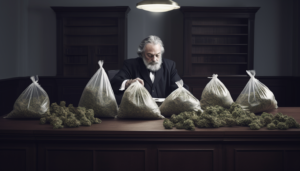
AI Stockfoto: Midjourney prompt “judge in court with bags full of cannabis flowers on desk, 3d, dramatic lighting”
Cannabinoid Regulation
One of the most significant challenges in regulating cannabis lies in the varying legal status of different cannabinoids. While some cannabinoids, like THC, remain federally illegal in many countries, others, like CBD, have become more widely accepted and regulated. This disparity in treatment can have implications for the entourage effect, as it may limit the development and distribution of full-spectrum cannabis products that contain both THC and CBD.
Medical vs. Recreational Cannabis
The legal status of cannabis varies depending on whether it is being used for medical or recreational purposes. In some jurisdictions, medical cannabis is permitted, while recreational use remains prohibited. This can have a direct impact on the entourage effect, as medical cannabis products may be subject to stricter regulations and guidelines, potentially limiting the availability of specific strains or product formulations that could maximize the benefits of the entourage effect.
Labeling and Marketing Requirements
To help consumers make informed decisions, some jurisdictions have implemented labeling and marketing requirements for cannabis products. These requirements may mandate that cannabis products include information on their cannabinoid and terpene content, allowing consumers to better understand the potential entourage effect of the product. However, inconsistencies in labeling requirements between jurisdictions and a lack of standardization can make it challenging for consumers to accurately compare products or gauge the entourage effect.
Quality Control and Testing Standards
The entourage effect highlights the importance of quality control and testing standards in the cannabis industry. To ensure the safety and efficacy of cannabis products, regulators may require that they undergo testing for potency, purity, and the presence of contaminants. These standards can help ensure that consumers have access to high-quality cannabis products that deliver the desired entourage effect, but variations in testing requirements between jurisdictions can create challenges for producers and distributors.

AI Stockfoto: Midjourney prompt “mendel menachem inspecting cannabis with a microscope in his laboratory, 3d, disney, dramatic lighting, rendered”
International Considerations
As the global landscape for cannabis regulation continues to evolve, international considerations must also be taken into account. Different countries have adopted varying approaches to regulating cannabis and its constituent compounds, creating a complex legal landscape for businesses operating in the industry. Understanding and navigating these international regulations is crucial for the growth and development of the global cannabis market and the entourage effect.
As research on the entourage effect continues to progress, it is essential for regulatory and legal frameworks to evolve in tandem with scientific understanding. Striking a balance between promoting public safety and enabling access to the potential benefits of the entourage effect will be key to the future development of the cannabis industry and its therapeutic applications.
The Importance of Personal Experience and Variation Due to the Entourage Effect
The entourage effect, which refers to the synergistic relationship between cannabinoids, terpenes, and flavonoids in cannabis, has been gaining increasing attention in recent years. However, the interaction between these compounds is not uniform across all users, and individual experiences may vary due to factors such as personal biology, specific cannabis strains, and consumption methods. This article will highlight the importance of personal experience when it comes to the entourage effect and the reasons behind these variations among users.
Personal Biology and the Entourage Effect
Each person’s unique biological makeup, including factors such as genetics, metabolism, and endocannabinoid system function, can influence how they experience the entourage effect. For example, genetic variations in cannabinoid receptors and metabolic enzymes can affect how an individual processes and responds to cannabinoids like THC and CBD. As a result, two people consuming the same cannabis product may have entirely different experiences due to their personal biology.
Cannabis Strains and the Entourage Effect
The entourage effect is also influenced by the specific cannabis strain being consumed. Cannabis strains can differ significantly in their cannabinoid and terpene profiles, which ultimately affects the entourage effect they produce. For instance, a strain with a high THC content and a specific terpene profile may provide more potent psychoactive effects, while a strain with a balanced THC:CBD ratio and a different terpene profile may offer more nuanced or therapeutic effects. This diversity in cannabis strains underscores the importance of personal experimentation in discovering which strains and combinations of compounds best suit an individual’s needs and preferences.
Consumption Methods and the Entourage Effect
The method of cannabis consumption can also impact an individual’s experience with the entourage effect. For example, inhalation methods such as smoking or vaporizing may deliver a more rapid onset of effects, while oral consumption through edibles or tinctures typically leads to a slower and more prolonged experience. Additionally, the bioavailability of cannabinoids and terpenes can vary between consumption methods, potentially altering the overall entourage effect. By experimenting with different consumption methods, individuals can determine which approach provides the most desirable effects for their unique needs.
The Role of Personal Experience
Given the variations in personal biology, cannabis strains, and consumption methods, it is crucial to recognize the importance of personal experience when it comes to the entourage effect. Each person’s journey with cannabis is unique, and understanding one’s own preferences and sensitivities is key to optimizing the benefits of the entourage effect. Open communication with healthcare professionals, cannabis educators, and fellow users can help individuals navigate their cannabis journey and identify the best strains, consumption methods, and dosages for their personal needs.

Meme Break: Posted by Mike Cunningham on Twitter
In conclusion, the entourage effect is a complex and dynamic phenomenon that varies among users due to individual factors. Embracing the importance of personal experience is essential for harnessing the full potential of the entourage effect and finding the right balance of cannabis compounds to meet one’s unique needs and preferences.
The Entourage Effect: A Closing Summary on Cannabis’ Synergistic Phenomenon
As our exploration of the entourage effect comes to a close, it’s essential to revisit the core elements of this complex and fascinating phenomenon that is reshaping our understanding of cannabis and its potential therapeutic and recreational applications. This article provides a concise summary of the entourage effect and its implications in the context of cannabis.
The Entourage Effect: An Overview
The entourage effect refers to the synergistic interaction between the many compounds found in the cannabis plant, including cannabinoids like THC and CBD, terpenes, and flavonoids. Instead of acting independently, these compounds work together to create a range of effects that are often greater than the sum of their individual contributions. The entourage effect highlights the importance of considering the whole plant and its diverse constituents when evaluating the potential benefits of cannabis.
Personal Experiences and Variations
One of the critical aspects of the entourage effect is the recognition that individual experiences can vary significantly. Factors such as personal biology, specific cannabis strains, and consumption methods can all influence how a person experiences the entourage effect. This variation underscores the importance of personal experimentation and adaptation in finding the right balance of cannabis compounds to meet individual needs and preferences.

AI Stockfoto: Midjourney prompt “man smoking joint on balcony in bangkok, nightime, bangkok skyskrapers”
Implications for Cannabis Research and Use
The entourage effect has far-reaching implications for the future of cannabis research and use:
- Therapeutic applications: A deeper understanding of the entourage effect can lead to the development of more effective and targeted cannabis-based therapies for a wide range of medical conditions.
- Cannabis cultivation and breeding: Recognizing the importance of the entourage effect may encourage cultivators to focus on breeding and growing techniques that optimize the balance of cannabinoids, terpenes, and flavonoids in cannabis plants, leading to strains with specific desired effects.
- Consumer education and personalization: As awareness of the entourage effect grows, consumers will likely become more knowledgeable about the complexities of cannabis and better equipped to make informed choices about strains and consumption methods that best suit their individual needs.
In conclusion, the entourage effect represents a critical paradigm shift in our understanding of cannabis and its potential benefits. By embracing the complexity of this synergistic phenomenon, we can unlock new possibilities for the therapeutic and recreational applications of cannabis and help usher in a new era of personalized cannabis experiences.

Nick High
Nick is a cannabis enthusiast and software developer. He is writing articles too, but only every so often. Follow him on Instagram
